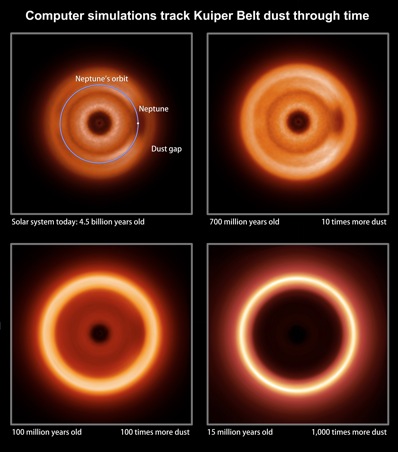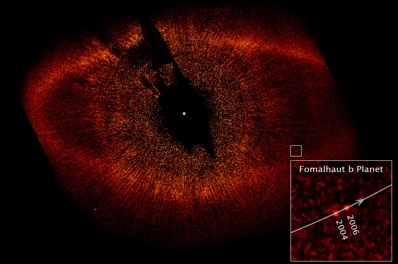



|

|

An alien's view
of our Solar System
by Nicky Guttridge
for ASTRONOMY NOW
Posted: 30 September 2010


New computer simulations that track the interactions of thousands of dust grains show what our Solar System might look like to extra-terrestrials.
The research, carried out by a team based at NASA’s Goddard Space Flight Center, used new supercomputer simulations to track the interactions of thousands of dust grains originating from the debris cloud in the outer reaches of our Solar System, the Kuiper Belt. As well as providing a view of the present Solar System the researchers also modelled the dust progress over time, showing how it may have looked in the past and providing insight into long-term dust movement. “We’re hoping our models will help us spot Neptune-sized worlds around other stars,” says Marc Kuchner of NASA’s Goddard Space Flight Center, lead author of the study.

Computer simulations track Kuiper Belt dust through time. These images, produced by computer models that track the movement of icy grains, represent infrared snapshots of Kuiper Belt dust as seen by a distant observer. By ramping up the collision rate, the simulations show how the distant view of the solar system might have changed over its history. Image: NASA/Goddard/Marc Kuchner and Christopher Stark.
The Kuiper Belt is a region located beyond Neptune that contains millions of icy bodies, including Pluto, and is a feature that exists around many stars. It is believed to be older and leaner than the observed debris discs around stars such as Vega and Fomalhaut. Objects in the Kuiper Belt often collide, creating flurries of icy particles that are affected by many different forces. Solar wind interactions, sunlight, and the gravitational pull of the Sun and other nearby planets all have a strong effect on Kuiper Belt dust grains, making it difficult to accurately model their behaviour.
“People felt that the collision calculation couldn’t be done because there are just too many of these tiny grains too keep track of,” says Kuchner. “We found a way to do it, and that has opened up a whole new landscape.”
The study was carried out with the help of NASA’s Discover supercomputer, and focussed on the dynamics of 75,000 dust particles. The size of the particles varied massively, ranging from 1.2 millimetres – the width of a needle’s eye – to more than a thousand times smaller, similar in size to particles present in smoke. The simulation is the first to factor in collisions between the grains, and works by dividing dust grains into the three possible orbits they can inhabit based on current ideas of Kuiper Belt dust production rates.

Simulated images of the ancient Kuiper Belt bear a striking resemblance to this Hubble Space Telescope view of the dusty ring around Fomalhaut, a young star located 25 light-years away in the constellation Piscis Austrinus. In 2008, Hubble spotted a planet orbiting inside the ring. The bright central star is masked out so that the faint ring can be seen. Image: NASA/ESA/P. Kalas (Univ. of California, Berkeley) et al.
The researchers used the resulting data to produce synthetic images that represent infrared views of the Solar System as seen from afar. These images show that Neptune has a particular influence in shaping dust patterns, and forces particles into a certain orbit through gravitational effects called resonances. This creates a clear zone near the planet and forms dust patterns that track the planet through its orbit. The simulation also shows that dust particle collisions tend to destroy larger dust particles before they drift too far from where they originate, resulting in smaller particles and a relatively dense dust ring that straddles Neptune’s orbit.
Other simulations aimed to investigate what a younger and bulkier Kuiper Belt may have looked like through speeding up dust production rates. This mimicked the conditions present in the Solar System’s past, when the Kuiper Belt contained many more bodies that collided more frequently, therefore producing more dust. The researchers ran several simulations with increasing production rates, producing images that correspond to dust generation that was 10, 100 and 1000 times higher than in the original model. “We were just astounded by what we saw,” says Kuchner.
As the rate of dust generation increases the number of dust grain collisions increases, and the chance of larger dust grains existing to drift from the Kuiper Belt drops very sharply. Reverting into the past for these simulations shows the broad dusty ring that is seen today morphing into a dense, bright ring that is remarkably similar to those seen around other stars – Fomalhaut in particular.
“One of our next steps will be to simulate the debris discs around Fomalhaut and other stars to see what the dust distribution tells us about the presence of planets,” says Stark. Along with this, the team plans to develop a more complete picture of the Solar System’s disc by modelling additional sources closer to the Sun, including the asteroid belt and the effect of Jupiter’s gravity on these asteroid populations.
|

|

|

|
|



